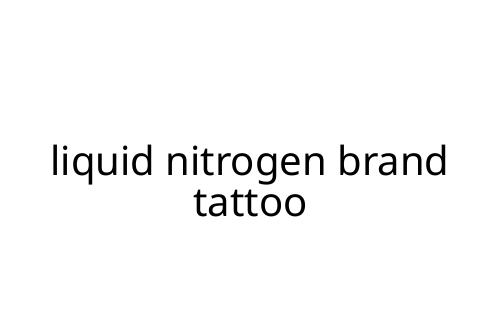liquid nitrogen brand tattoo
Curious about the liquid nitrogen brand tattoo trend? You’re not alone. Interest in this skin modification technique is climbing, especially on social media. But before you take the plunge, it’s important to understand what liquid nitrogen branding involves, why people consider it, and the essential risks and realities.
What is a liquid nitrogen brand tattoo?
Unlike traditional tattoos that use ink, a liquid nitrogen brand tattoo uses super-cold liquid nitrogen to freeze and permanently scar the skin in a chosen pattern. It’s a form of scarification, creating a design by destroying specific layers of skin tissue with extreme cold.
Branding with heat has historical roots, but cryogenic branding is relatively new to the mainstream. Some choose liquid nitrogen because it allows for finer, more precise lines compared to hot metal, and can seem less painful initially.
Why are people interested?
The appeal is partly visual—liquid nitrogen brand tattoos can look bold and unique. For some, the draw is the unconventional method and the idea of standing out. Others are looking for a body modification that’s not reversible and doesn’t use ink. The branding process is sometimes chosen for personal, cultural, or artistic reasons.
Pros and cons
Pros
- Distinct appearance: Results don’t look like traditional tattoos. Raised or recessed scars create an unmistakable look.
- Ink-free: No risk of allergic reaction to pigments.
- Symbolic value: The permanence and intensity carry personal meaning for some.
Cons
- Pain and healing: Branding is painful. Expect a long healing period with potential for significant discomfort and scarring complications.
- No guaranteed results: Skin can heal unpredictably, so final scars may not match your intended design.
- Health risks: Infection, keloid formation, and nerve damage are possible.
- Lack of regulation: Few practitioners are certified in liquid nitrogen branding. This increases risk of poor technique or unsterile conditions.
What to consider before getting one
If you’re considering a liquid nitrogen brand tattoo, research practitioners extensively. Ensure their equipment and methods meet safety standards. Be realistic about pain, healing time, and the permanent, unpredictable nature of the scar.
Discuss aftercare in detail. Proper hygiene, wound care, and regular check-ins are essential to reduce complications. Be cautious about aftercare products: some standard tattoo balms may be unsuitable for this type of injury.
Alternatives
Traditional tattoos or scarification (cutting or hot brand marks) offer different risks and outcomes. If you’re motivated by the artistic aspect, consider consulting with a professional about designs and what’s safest for your skin type and health history.
Bottom line
A liquid nitrogen brand tattoo is not a decision to take lightly. Compared to ink tattoos, the risks are higher and the results unpredictable. If you value uniqueness and are prepared for the realities of the procedure, do your homework and choose your artist with extreme care. Body modification always carries risks, but informed preparation can minimize them.

 Michael Matherne has been instrumental in the development of Villa Estates Luxe, leveraging his extensive background in real estate and digital marketing to shape the platform's success. His strategic insights have been crucial in curating the latest news and market trends, ensuring that users receive timely and relevant information tailored to their needs. Michael has also been pivotal in enhancing the overall user experience, implementing innovative features that make navigating the site seamless. His commitment to providing high-quality content and fostering a community of informed buyers and investors has significantly contributed to Villa Estates Luxe’s reputation as a trusted resource in the luxury villa market.
Michael Matherne has been instrumental in the development of Villa Estates Luxe, leveraging his extensive background in real estate and digital marketing to shape the platform's success. His strategic insights have been crucial in curating the latest news and market trends, ensuring that users receive timely and relevant information tailored to their needs. Michael has also been pivotal in enhancing the overall user experience, implementing innovative features that make navigating the site seamless. His commitment to providing high-quality content and fostering a community of informed buyers and investors has significantly contributed to Villa Estates Luxe’s reputation as a trusted resource in the luxury villa market.